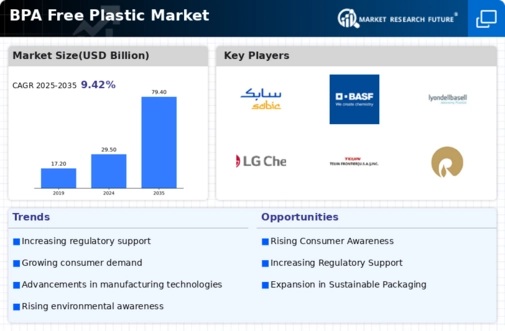Regulatory Support
Regulatory bodies across various regions are implementing stringent guidelines and regulations concerning the use of BPA in consumer products. This regulatory support is a significant driver for the BPA Free Plastic Market, as it compels manufacturers to transition towards safer alternatives. For instance, several countries have enacted bans on BPA in baby bottles and food containers, thereby creating a favorable environment for BPA-free products. The market is witnessing a surge in compliance-driven innovations, with companies investing in research and development to create BPA-free materials that meet regulatory standards. This trend is expected to enhance the market's growth trajectory, as adherence to regulations not only ensures consumer safety but also fosters brand loyalty among health-conscious consumers.
Consumer Health Awareness
The increasing awareness among consumers regarding health and safety issues associated with traditional plastics has propelled the BPA Free Plastic Market. Consumers are becoming more informed about the potential risks of Bisphenol A (BPA), which has been linked to various health concerns, including hormonal disruptions and reproductive issues. This heightened awareness is driving demand for BPA-free alternatives, as consumers seek safer options for food and beverage packaging. Market data indicates that the BPA Free Plastic Market is projected to grow at a compound annual growth rate (CAGR) of approximately 6% over the next five years, reflecting a shift in consumer preferences towards healthier products. As a result, manufacturers are increasingly focusing on developing BPA-free solutions to cater to this growing demand.
Technological Innovations
Technological advancements play a crucial role in shaping the BPA Free Plastic Market. Innovations in material science and manufacturing processes are enabling the development of high-performance BPA-free plastics that meet diverse consumer needs. For instance, advancements in polymer technology have led to the creation of BPA-free alternatives that exhibit superior durability and flexibility, making them suitable for a wide range of applications. The market is witnessing an influx of new products that leverage these technological innovations, catering to sectors such as food packaging, healthcare, and consumer goods. As companies continue to invest in research and development, the BPA Free Plastic Market is likely to experience accelerated growth, driven by the introduction of innovative solutions that align with consumer expectations.
Sustainability Initiatives
The growing emphasis on sustainability and environmental responsibility is reshaping the BPA Free Plastic Market. Consumers and businesses alike are increasingly prioritizing eco-friendly products, leading to a surge in demand for BPA-free plastics made from renewable resources. This shift is driven by a collective desire to reduce plastic waste and minimize environmental impact. Market data suggests that the demand for sustainable packaging solutions is expected to rise significantly, with BPA-free plastics being at the forefront of this movement. Companies are responding by adopting sustainable practices, such as utilizing biodegradable materials and implementing recycling programs. This alignment with sustainability goals not only enhances brand reputation but also attracts environmentally conscious consumers, further propelling the growth of the BPA Free Plastic Market.
Rising Demand from End-Use Industries
The BPA Free Plastic Market is experiencing a surge in demand from various end-use industries, including food and beverage, healthcare, and consumer goods. As these sectors increasingly adopt BPA-free materials to comply with health regulations and meet consumer preferences, the market is poised for substantial growth. For example, the food and beverage industry is shifting towards BPA-free packaging solutions to ensure product safety and enhance consumer trust. Additionally, the healthcare sector is embracing BPA-free plastics for medical devices and packaging, driven by the need for safer alternatives. Market projections indicate that the BPA Free Plastic Market will continue to expand as end-use industries increasingly prioritize health and safety, thereby creating a robust demand for BPA-free products.


















Leave a Comment